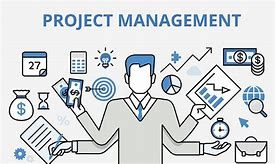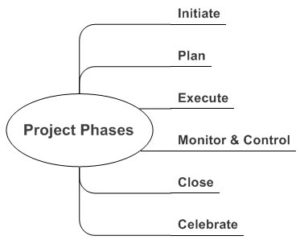How to Accomplish More with Project Management

Yes you can accomplish more with project management and who doesn’t want to accomplish more? Today you have so many competing priorities. When you use a system to help you manage those priorities you will feel happier and less stressed.
What is Project Management
Project management is a methodology or way of doing things with structure and ease. You can use project management for work and home projects. The Project Management Institute (PMI) defines a project as a temporary endeavor undertaken to create a unique product, service or result.
By applying knowledge, skills, tools, and techniques to project tasks, to help meet the project goals, you are using project management. Here’s how it works.
The Phases of Project Management
There are 5 phases of project management. The figure below shows the 5 phases plus an added phase of celebrate. It is so important to take time to celebrate your success before moving on to the next project. You finally cleaned out your closet, celebrate. You delivered a quality component to the customer, on time and within budget, celebrate! Don’t wait for someone else to pat you on the back. Pat your own back, Jack… or Jill! 🙂

The 5 official phases of project management are Initiate, Plan, Execute, Monitor & Control, and Close.
Phases 1 & 2
Phase 1) Initiate: Before starting any project ask yourself why am I doing this. In business, you need to ask if the project is in line with your core offerings. Therefore, you need to know what benefit you or your customer will receive as a result of doing the project. When you are clear on the reason why you are doing something you can proceed. By beginning with the end in mind you will remain motivated to complete the project. You will also need to think about who will be impacted by the project to get their input during the planning phase.
Phase 2) Plan: Have you heard the statement, “failing to plan is planning to fail?” It is true because a few minutes or hours, of planning, depending on the size of the project, can save you weeks and months of stress and rework. Ask yourself the following questions:
- What tasks must be done to complete the project?
- Who are the people I need to help me?
- What type of budget do I have to achieve the goal?
- When does the project need to be completed?
Timing: The Most Important Part of the Planning Process
The biggest part of the planning process that most people struggle with, including myself, is timing. Set an expected completion date and stick to it. Additionally, set milestone dates to keep you accountable and to help you with your progress. Here’s an example: If your goal is to clean out your closet within a month, you might set weekly milestone/check-in dates to insure you are making progress.
- Feb 7: Bottom of closet is cleared out, shoes are put in boxes.
- Feb 14: Clothes are sorted and sizes 6, 8, 10’s….you get the idea, that no longer fit, are in the bag for Vietnam Veterans Association (VVA) pick-up.
- Feb 21: Work and dressy clothes are on one side of the closet, casual clothes are on the other side.
- Feb 28: The clothes are cleaned, the closet is clear, and now it’s time to shop for new clothes! Yeah, just kidding. Although you might plan to celebrate by maybe buying one (1) new top!
Phases 3, 4, and 5
Phase 3) Execute: Once you have laid out the plan with timing and milestones, you can start actually doing the work.
Phase 4) Monitor & Control: As you are doing the work you want to make sure you are staying on track according to your original plan. Adding to the plan/scope of the project is called scope creep. So, if you decide to have “California Closets” design a whole new closet for you instead of sticking to the original plan of just cleaning out your closet you are causing scope creep. You are now adding timing and costs to the project and causing scope creep. Don’t be a creep, stick to the original plan.
Phase 5) Close: This phase signals the completion of the project. If you are delivering a product to a customer, there may be sign off sheets and product acceptance forms to sign. If it is your own personal project you can enjoy the benefits of a job well done.
In Conclusion: Now it’s Your Turn
Start using the process and let me know how it helps you. Remember, new practices take time to become a habit. By starting with a small project first, you will be able to build up your confidence. After that, celebrate your success then try the project management methodology on a larger project. Before you know it you will be getting more accomplished and feeling less stressed. However, if you would like some additional information or help, feel free to contact me.

